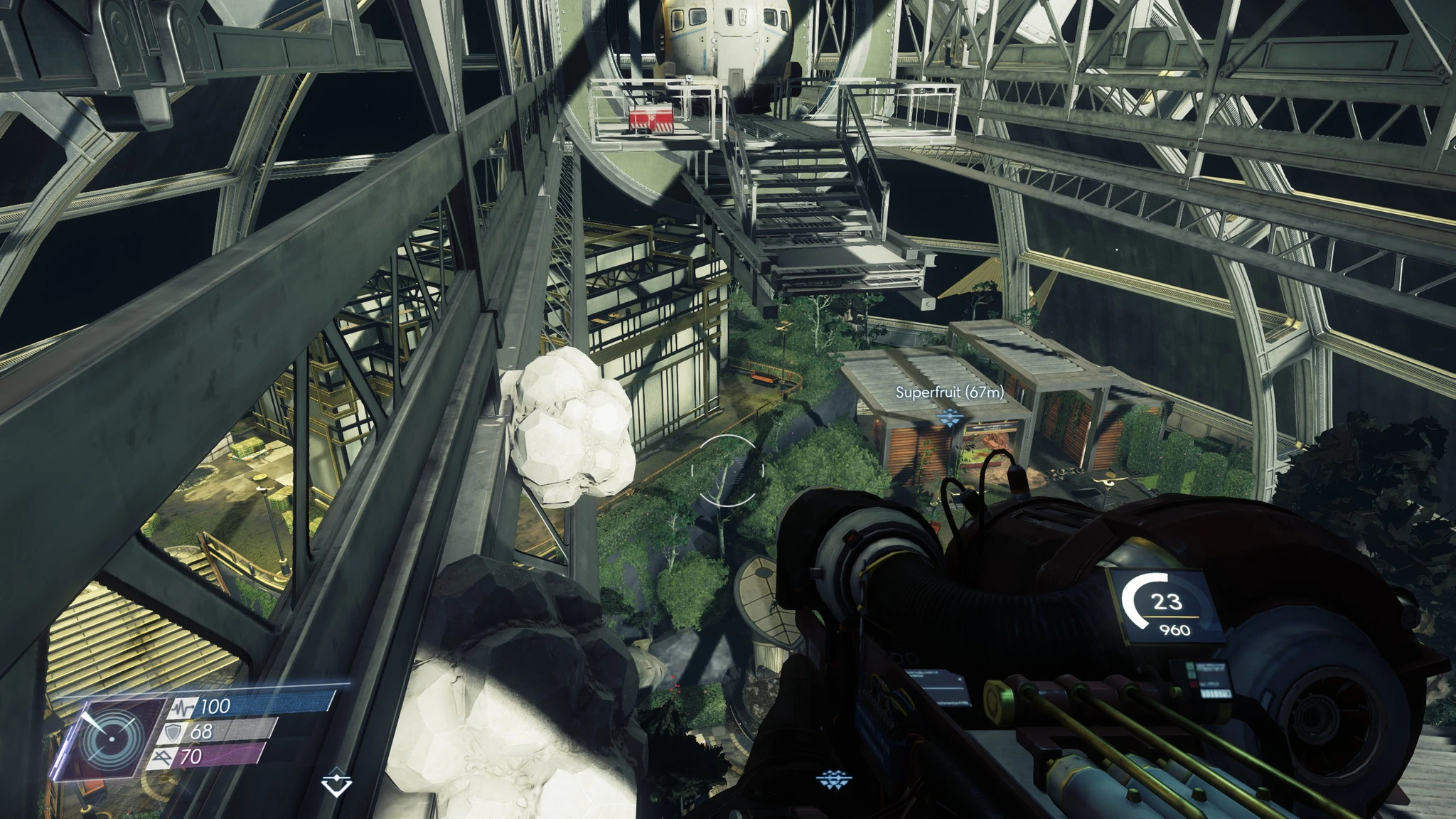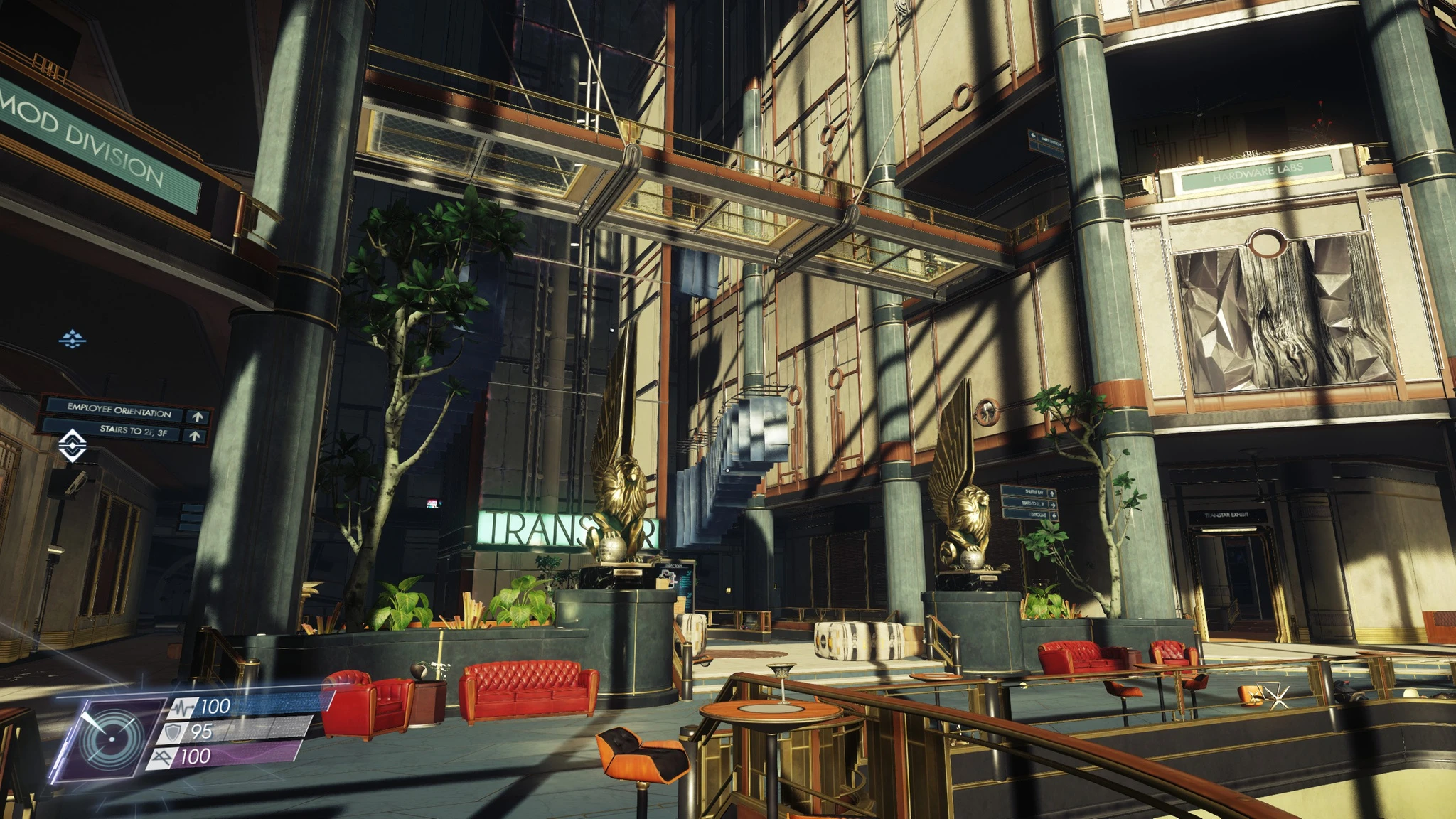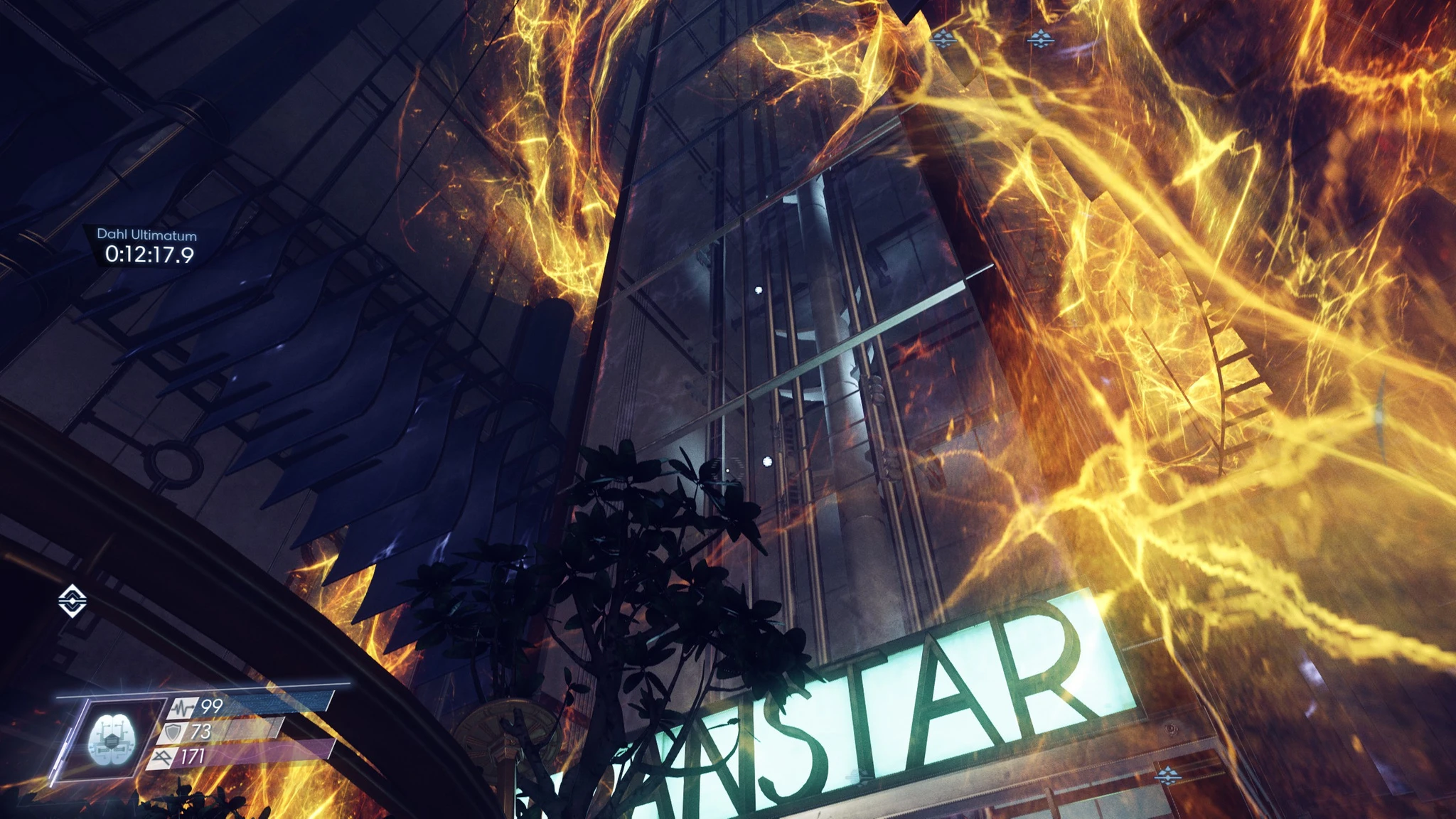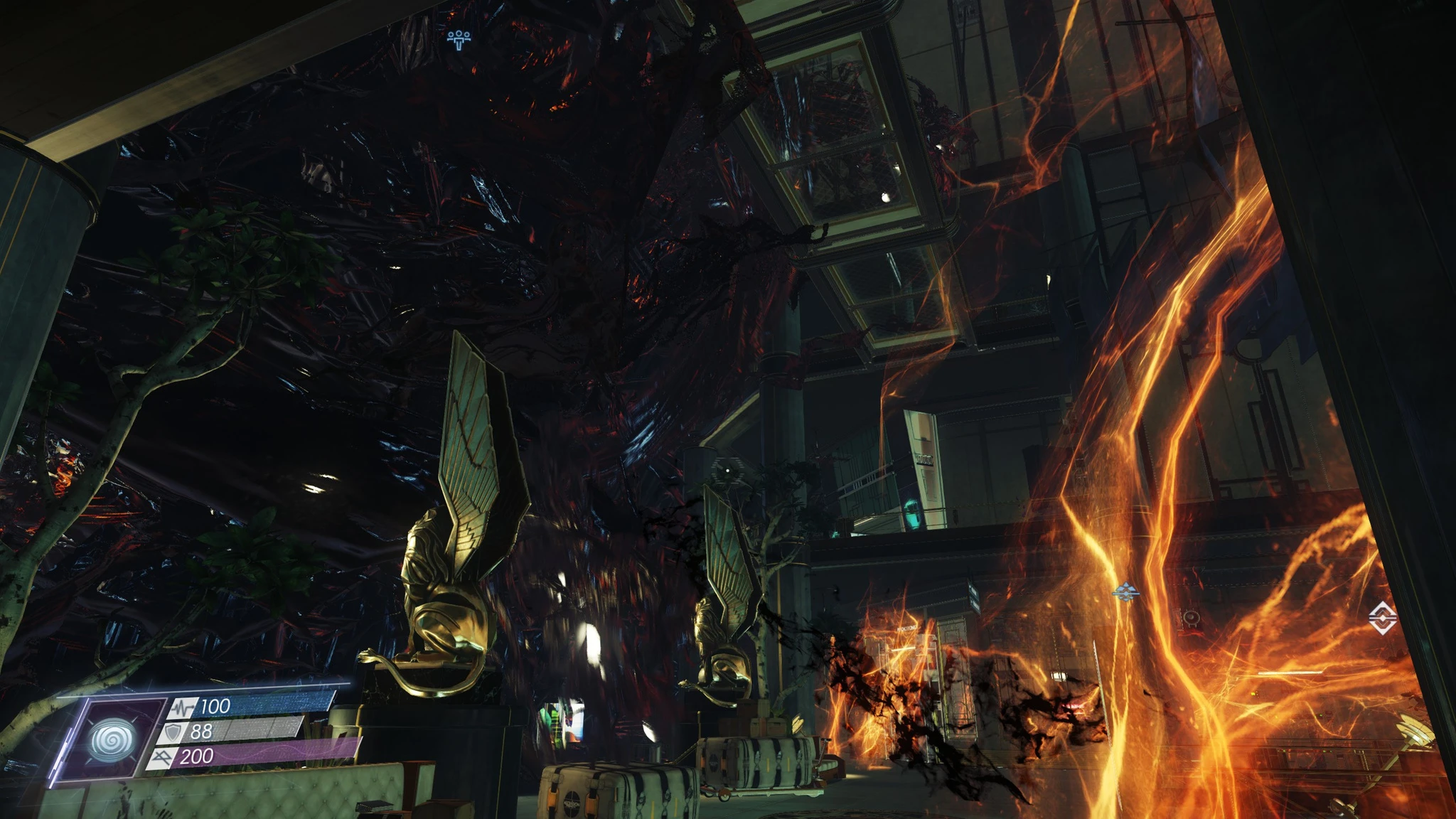Prey is an perfectly serviceable AAA-class, science-fiction survival thriller game. It’s a first-person shooter, a stealth adventure, and a surprisingly enjoyable platformer. The plot is all right. The art is iconoclastic and gorgeous. As is traditional for the genre, much of the storytelling transpires through the environment: emails, voice logs, and diorama. There are some lovely ethical questions, both abstract and reified. For some reason, these are the things that people talk about when they talk about Prey.
After all, Prey is a videogame, and gameplay, art direction, and story are how we read videogames as texts. But I’d like to step back for a moment and talk about Prey’s symbolic and thematic choices, which are absolutely fucking fascinating. Spoilers ahead.
Penetration and Containment
Prey is a fantasy wrapped in a nightmare wrapped in a reverie. Like so many thrillers, it takes the device of a framing narrative and turns it inside out. We open in Morgan’s apartment, which we discover is a simulation: a laboratory to study her personality and abilities through Neuromods, and now, an iterative prison. Morgan lives each day over and over again, her memory reset to the injection of her first Neuromod. The laboratory envelops her in its idyllic dreaming. Around her, the world is collapsing.
When Morgan smashes the glass door of her apartment, and steps through into the darkened lab beyond, she penetrates narrative boundary, emerging into the frame story of Talos I. We discover the world is not what it was. We gain access to the past, and are troubled by it.
Throughout Talos I, Alex tries to contain us: blocking the video, warning us against Psychotronics, withholding the arming key, locking us into Deep Storage. But we persist, we invade, we intermingle: sneaking through ducts, hacking security systems, skulking up the twisted spine of the station. We take Typhon and Human techne and inject it into our brains. We invade the minds of our enemies and repurpose them to our ends. We delve into the heart of the Coral and place our technology there.
In the epilogue, we emerge into a third frame: an undisclosed location on Earth. The “flashbacks” we experienced were a glimpse into that world. We discover that our experience on Talos I was, in fact, another class of simulation. Like the prologue, both simulations are morality tests—explicit, then implicit. Alex has wrapped us in an illusory world in order to understand our psyche.
After all, we are Typhon, and the story of human and Typhon is the story of envelopment and penetration. There’s a museum dedicated to it, in the Lobby of Talos I. The station, they explain, was constructed by the TranStar corporation, wrapping a US R&D station, which was constructed around the US-Soviet Kletka (literally “cage”) station, which in turn contained the Vorona I satellite.
It was Vorona I which was first penetrated by the Typhon, who, in footage of the first human-Typhon encounter, burrowed their way through the face-shields of the repair team to consume them. Kletka enveloped the satellite, but was itself infested. “After an unfortunate containment failure led to the death of an entire research team,” we learn, the TranStar corporation cleared the station and established Talos I. Prior to the events of Prey, the Typhon broke containment again, consuming Talos I. Nowhere is this more spectacular than the arrival of the Apex, which seethes throughout the station, a roaring mass of tentacles tearing at the walls. We know from the epilogue that we failed to contain them then, and ultimately, the Typhon invaded Earth.

In light of all this, it is not at all surprising that the player isn’t strictly human. Yes, Morgan’s mission is containment, in preventing the alien threat from spreading to Earth. But her praxis is pure Typhon. She resists enclosure. She is invasive to her core.
It is no accident, I think, that the game’s hopeful ending hinges on an inversion of envelopment and penetration. After repeated failures to enclose the Typhon, humans decide to infect a Typhon themselves, and determine whether it would act in favor of containment.
Like the IDF employing critical theory as a method of warfare, Morgan treats paths as walls, and walls as paths. Stealth and hazards force her away from catwalks and corridors. She smashes through glass—sometimes transparent, sometimes holographic—to reach her objectives. She transforms into teacups and skitters through crevices. Her powers reach through gratings and across chasms to retrieve distant objects. She lobs recycler grenades into piles of junk blocking her path, literally deconstructing the blockades erected by Talos’ frightened humans. Remember, this is a game which takes the repurposing of the environment so seriously that every level includes a recycling facility, converting unused weapons and food scraps to useful tools.

The ultimate expression of this philosophy is the GLOO gun. A delightfully game-breaking piece of technology, GLOO turns walls into staircases, columns to ladders, rafters to catwalks. This is part of why Prey’s offers such forgiving, fluid movement—we leap for railings, grab frantically to ledges, and leap for pipes, because we are encouraged to take unconventional paths. Like its predecessors, System Shock and BioShock, much of the game is about unlearning our schemas for interaction with the world. Many problems are easily solved—the challenge is in remembering to think outside the cage.
Of course, to create this experience, Prey’s designers cannot truly allow us to penetrate any wall. There are technological and gameplay limits to consider. As Reid McCarter writes, every inch of the station has been meticulously groomed to support alternative traversal. Prey explicitly supports alternative readings of environments and enemies. We feel clever, unconventional, invasive—but our solutions to problems were largely foreseen by the designers.
This aporia is where, a critical theorist might declaim, Prey deconstructs itself.
Appearance and Substructure
Appearances can be deceiving. Prey’s mimics literally embody the aphorism: every object is a potential threat. Players learn to distrust the environment, smashing teacups and boxes just in case. However, the game has much more to say about appearances, and as a survival thriller, much of that storytelling takes place obliquely, through the setting of Talos I.

Prey has a peculiar relationship with glass. For starters, it’s filled with it. Glass walls, windows, floors. Glass panels hanging from the ceiling, with lights behind. There is regular glass, which is transparent and can be shattered to form a path. There is reinforced glass, which is impenetrable. Where BioShock drew on Art Deco, Prey references Structural Expressionism—rooms filled with ducts and pipes, exposed girders and machinery, then walled away behind massive sheets of glass from floor to ceiling. Glass is, for what I assume are gameplay reasons, the only material GLOO won’t stick to.
But then, there’s Looking Glass, and this is the most interesting material in Prey.
Your apartment’s windows offer a barrier to a view, but when smashed, become a portal to the Sim Lab. The Arboretum’s waterfall is fake, and if you smash it by accident, perhaps by fighting mimics pretending to be lilypads, you’ll fall into a secret room. Walk around the corner, and you’ll find yourself on the opposite side of what you thought, earlier, was a fishtank. Sometimes Looking Glass terminals show a recording of the same room—or a different one—from a previous point in time. By walking around them, you can observe hidden details. In Psychotronics, the Looking Glass terminal appears, for once, to be truly transparent, with a calibration pattern. This transparency, however, is a lie: sneaking around to the back side of the glass reveals subtle differences between the current room and what the Looking Glass shows. Like a mimic, the Glass is pretending to be something it’s not—and if you touch it, well, we know the consequences.

In Dr. Calvino’s quarters lies a tiny model of a coastal village during a thunderstorm, and a camera. The Glass display on the wall shows the same diorama, writ large. Listening to Dr. Calvino’s logs tells us that he started work on this diorama in an effort to preserve his failing memory. It’s a poignant moment, and another reference to simulation; we have been (and are still) under a microscope in our own tiny, constructed world. Behind this Glass lies Calvino’s safe, keyed to the birthday of the wife he can no longer remember. Though Calvino is now dead, it feels disrespectful to interrupt his memorial reverie.
Even the design of the Talos I bridge reiterates the theme of false transparency. As with the bridge of Dead Space’s Ishimura, Prey’s bridge presents a spectacular, high-windowed vista of the heavens. Unlike the Ishimura, these windows are a simulation, a Looking Glass projection. We can smash the glass and walk around behind. Standing in the bridge, we become a homunculus inside the skull of the station. With no direct access to the stars, our experience is mediated, projected on a screen—and critically, we look inwards, not out. This is the architectural equivalent of beating someone over the head with a wrench while shouting, “Look out for the metaphor!”


There is precisely one mirror in the game. At the character selection screen, we see Morgan Yu, staring herself (or himself) in the eyes. She is nervous. The reflection glitches uncannily. Sometimes her eyes appear, for a moment, bloody. We cannot trust this reflection either.
I argue that Prey places so much emphasis on transparency and reflection because it is thematically concerned with the unknowability of the self, the Real, and the Other. We come into the world amnesiac, and look to the world to tell us who we are, but while looking to the world, we must question again and again whether the surface maps to what is underneath. Not only can we not know others, but we cannot know our selves.
In Yu’s suite, the book “Proxies, Agents, and Personhood” raises the issue of an AI facsimile of a person being granted Power of Attorney over the original person’s will. Are they indistinguishable? After all, you’ve spent most of the game listening to an operator which purports to be an agent of your will, and it speaks with your voice—but when you discover there are two previous iterations of that operator, which disagree, the question of faithful representation becomes much more complex. When we emerge into the epilogue, we discover operator proxies for Igwe, Ilyushin, and Elazar, who presumably died on Talos I. These constructs evaluate our imitation of humanity.
And what is our moral valence? That which is alien is a proxy for the unknown. Are we, the Typhon with a sliver of humanity, capable of empathy? Of seeing humans “like we see ourselves”? As Alex says, they have no way to know, but they must decide nonetheless: on the basis of appearances. It’s an uncanny thought to have, as a human player who has decided to project a moral framework into their gameplay.
Alex and the operators only have access to our behavior in the simulation; our appearance, our surface. Yet as Prey reiterates throughout, appearances are not to be trusted. We must, therefore, have the choice to join him, or to prove Alex’s trust wrong; to have done everything right, and then, finally, to kill him after all.
Remembering, Forgetting, Identity
“Unreliable narrators are a dime a dozen,” Prey quips, and stuffs Talos I with a nickel’s worth of dissimulating simacrula, quarreling ghosts, and amnesiacs scratching in the dust for traces of their past selves. There are no fewer than six Morgan Yus, and possibly dozens.
One, we presume, is the real Morgan Yu, queen of Citadel Station, whose story we can only imagine in broad strokes. The epilogue claims her brother Alex is real, as are the Typhon, but since our entire experience was a simulation, we have no way to determine how much of Talos I and Morgan’s story was real. Even if the simulation is a faithful recreation, Prey is a videogame which affords players considerable latitude, which means we have only a small chance of recreating Morgan’s actual journey. Prey forces us to confront a truth often overlooked in games: characters aren’t merely inhabited, but partly invented by players.
We have recordings—videos, audio logs, and emails—from Morgan. These are as close to meeting the real Morgan as the game will let us get, but we have no way to know what the supervising Alex, the historical Alex, and January have done to those recordings. Even if they are unedited, they contradict one another. The real Morgan, we believe, was fractured in time, her memory erased repeatedly, her personality drifting with the daily removal of Neuromods. Notes scattered around the station imply that entire departments were routinely memory-wiped. Eventually, we too are offered the choice to edit Dahl’s memories, and to lie to him so that he can “choose” to save the crew of Talos I. Memory is inherent in the construction of a coherent self, but Prey insists that memory can be hurtful, and in a consequentialist ethics, immoral.

Then, there are the chorus of Morgan’s ghosts, the shadow operators, each purporting to be her past self. We meet December, who advocates selfish escape so we can warn Earth of what has happened. January, who politely but firmly corrals us to destroy Talos I. Their agendas bring our contradictory past beliefs into present conflict: we can choose to destroy January and follow December, or allow January to destroy December and leave us wondering which of ourselves to believe. There is also a single reference to a third, older operator: October.
Of course, none of these operators are Morgan herself. They are facsimiles, independent constructs with directives, so they claim, from the real Morgan. Or perhaps they are agents of Alex’s simulation, to serve as our externalized conscience. They speak with Morgan’s voice to put as at ease, January explains, but this only heightens our anxiety. Even our consciences cannot be trusted. In the twilight moments of Talos I, an audio log from Morgan herself reveals that when this whole endeavor started, she planned to use the Nullwave device to kill the Typhon, and Alex would try to blow up the station. Why are the roles reversed now?
Finally, there is the Typhon, sitting in Alex’s simulation chair, dreaming itself to be Morgan Yu, imagining she is in her apartment, back on earth. In turn, we players imagine ourselves to be that Typhon. Throughout the game, it is engaged in a process of self-discovery: reading Morgan’s old emails, listening to her audio logs, meeting her colleagues, saving her former lover. This self-discovery is in some sense false: this Typhon didn’t make those recordings, didn’t work on Talos I, never held Mikhaila Ilyushin in its seething tentacular embrace. But through the game, it may as well have. Like a Looking Glass, it gives the appearance of morality, of a conscious, empathetic inner life. With every decision, it creates a self, inhabits Morgan’s identity.
Perhaps, as the game’s rare survivors comment, the Typhon is a more moral person than the real Morgan ever was. Or perhaps that real Morgan, memories wiped and faced with the containment crisis on Talos I, created a new and better self through her choices too. As Mikhaila notes, if you retrieve the logs of her father’s execution: that wasn’t the same Morgan. It was someone else.
The Real and the Symbolic
In Lacanian psychology, the Real is the undifferentiated mass of the physical world, the electrons, protons, and light, the stuff which actually exists. The Symbolic is the language of structure which we superimpose on the world. Humans are comfortable in the Symbolic register—we think in terms of discrete categories, not raw sensory impressions. Indeed, humans are obsessed with taxonomies, with algebras, with languages. We establish clades and species. We construct languages for roads: here is where pedestrians walk, where bikes ride, where cars drive. We divide space into rooms joined by corridors. To the degree that reality is predictably well-organized, the Symbolic is a reasonable approximation for the Real, and we can go about our lives.
However, as Storey writes in Cultural Theory and Popular Culture, there are cases where the Real irrupts through the neat categories of the Symbolic, and we engage with it directly. One is as a child—Lacan assumes children perceive the world as undifferentiated, and gradually learn to engage with discrete symbols. The other is a natural disaster, when nature literally smashes our concepts of buildings, roads, and so on. Prey tells the story of both.

In the first few moments of a game, we are as infants, flooded with raw impressions: rocks, doors, snow, moss, creatures, sunlight. Because these impressions are fresh, we cannot organize them, and the world feels somehow new, undifferentiated, real. What objects can be climbed on? What can be destroyed? What hurts and heals us? Can we interact with that control panel, or is it immutable? As new players, we must learn the language of the game in order to function within it, adopting its categories, the grammar of its spaces, musical cues, weapons, and movements.
Initially, I think, we learn the language of space. What does an environment feel like? Where can we walk? Prey introduces us to the built environment of Talos I, where we settle in to reading the world as an inhabitant of the station would. Where one finds security stations. How doors work. How to use public transit. Eventually, we learn to see the higher-order grammar of the game—recognizing exactly what props are movable vs static. After forty-some hours in an RPG like Skyrim, players may find themselves tuning out the landscape and characters altogether, thinking in the abstract algebra of quest dependencies and combat statistics.

But it is that first stage—learning to understand the station like one of its inhabitants—that is critical to Prey’s environmental storytelling. Of course, Talos I makes no sense as a work of architecture. The only way for injured people to reach the hospital is by being carried up a flight of stairs. The only way for hardware engineers to get to and from their workplace is by walking through an executive conference room. Getting lunch requires a detour through the arboretum. I don’t know how shuttles get into the shuttle bay—perhaps they’re disassembled and carried through the airlock in pieces. But these things can be overlooked. It’s the feeling of the space that matters.
Like its spiritual predecessors, System Shock, System Shock 2, and Bioshock, Prey is a disaster story. We come into a station—in space or beneath the waves—which is largely intact. It must be intact, because we need time to internalize the language of the station. Only once we have ingrained that understanding of how levels are supposed to function can the game subvert that understanding through the force of natural disaster. In System Shock, cybernetics run rampant. In System Shock 2, the flesh of the Many infiltrates more and more of the Von Braun until, in the final levels, we plunge into its illegible bowels. In BioShock, the ocean is an omnipresent threat to the integrity of the environment; leaks become sprays become floods. Where once we walked, we flounder.
Through this analytic lens, Prey’s dialectic between penetration and containment is also the interplay between the Real and Symbolic. As Coral and Cystoids infest the station, one feels that the language of the world is under threat. In the final act, the Apex literally deconstructs the station. Its tentacles are not particularly dangerous to the player. The true violence of the Apex is against Structure.

When Alex and January comment on the Typhon, they say “they can’t see us… not the way we see ourselves. They lack mirror neurons.” They say they can’t help it. Like Rorschach, the non-conscious intelligence from Blindsight, the Typhon are terrifying by their denial of identity itself.
The opposition of the Real and the Symbolic is evident throughout Prey’s visual language. Human spaces have walls, floors, windows, control panels. Safety doors seal away hull breaches. Typhon spaces are filled with Coral: porous, amorphous, passing directly through walls in flagrant contravention of human traversable norms. Humans always wear their TranStar suits to protect them from the environment. Typhon bodies deny even the concept of a boundary, presenting a mass of sloppily associated tendrils, constantly seething, blurring, glitching. Limbs extrude unexpectedly, then shrink away. They duplicate themselves. The Nightmare, six meters tall, oozes through doors, contravening the time-honored videogame tradition of Hiding From Big Things In Small Spaces. Even their speech is somehow porous, like words through a blender.

The Mimic is a particularly ingenious expression of the Real; by masquerading as everyday objects, in imitating physics-engine jitter, they attack the categories of Props and Enemies. A good deal of Prey’s tension and humor derives from this confusion of the Symbolic. When a Typhon has a boundary, it is pretending to be something else.
Again, this is a video game, which means Prey reifies concepts like “an enemy”, “a gib”, and “a voice line”. The design of the Typhon is suggestive of the Real, but ultimately, you’re hitting game entities with a wrench, and their health bar goes down or doesn’t, and mugs turn out to be mugs after all, or not. Prey is a game about the breakdown of categories, but in so doing, is forced to construct them. When those categories become clearly legible, the world loses some of its sublimity.
But in those jaw-dropping moments, when the Real first presents itself as undifferentiated madness, unbound by structure, we feel awe.

I’m doing some research for a personal project (a birthday TTRPG one shot with friends, lifting the setting from Prey :}) and I happened upon this essay piece. I want to thank you for sharing such in depth thoughts.